Deforestation is the extensive removal of wooded regions, which frequently leads to degradation of the land’s quality. This phenomenon takes place due to a multitude of factors, including as the expansion of agricultural activities, logging operations, the development of infrastructure, and mining activities. Deforestation has significant environmental, social, and economic consequences.
Factors contributing to deforestation
Agricultural Expansion: Extensive deforestation occurs to establish expansive agricultural land for the cultivation of crops such as soy, and palm oil, and for raising livestock.
Logging, whether legal or illicit, plays a substantial role in the process of deforestation. Timber is extracted to construct buildings, produce paper, and manufacture furniture.
Infrastructure development entails the construction of roadways, motorways, and urban expansion, which results in the removal of forested areas.
Mining is the extraction of minerals and materials, which frequently necessitates the removal of extensive areas of forested land.
Fire, whether caused by natural occurrences or human activities, can result in deforestation. Slash-and-burn farming is a widespread technique that involves deliberately igniting forested areas to remove vegetation and prepare the soil for cultivation.
Environmental Consequences
Loss of Biodiversity: Forests harbour a substantial fraction of the Earth’s land-dwelling species. Deforestation results in the destruction of habitats, posing a significant danger to biodiversity.
Climate Change: Forests function as carbon sinks, sequestering CO2 from the atmosphere. Deforestation results in the liberation of stored carbon from trees, which subsequently contributes to the phenomenon of global warming.
Water cycle disruption: Forests are essential for maintaining the water cycle. Their elimination can result in alterations in precipitation patterns, water quality, and accessibility.
Deforestation can result in soil erosion due to the absence of tree roots that secure the soil. This can cause a decline in land fertility and the accumulation of debris in rivers and streams.
Effects on Society and the Economy
Indigenous tribes: Numerous indigenous tribes depend on woods for their living, cultural practices, and overall way of existence. Deforestation can result in the displacement of communities and the erosion of traditional knowledge.
Economic losses arise from deforestation due to the short-term benefits it offers in terms of logging and agriculture. However, in the long run, deforestation results in diminished ecosystem services and decreases the tourism potential.
Conflict arises when there is competition for land and resources, especially in regions where land rights are disputed.
Strategies and measures to address and reduce the impact of a problem or challenge.
Sustainable Forestry: Enforcing methods that enable the extraction of forest resources while safeguarding ecological well-being.
Reforestation and afforestation involve the deliberate act of planting trees to rehabilitate areas that have been depleted of their forest cover, as well as to establish new forests in regions that were previously devoid of trees.
Protected Areas: The creation of national parks and reserves to safeguard important forested regions from the destructive act of deforestation.
Legal and policy measures involve enhancing legislation and regulations to deter and combat unauthorised logging activities while promoting and rewarding sustainable land utilisation.
Education and Awareness: Promoting knowledge and understanding of the significance of forests and advocating for actions that contribute to their preservation.
In conclusion
Deforestation is a pressing problem that has significant consequences for the ecosystem, biodiversity, climate, and human societies. To tackle this issue, a comprehensive strategy that encompasses sustainable practices, regulatory frameworks, and international collaboration is needed to safeguard the world’s forests for future generations.
